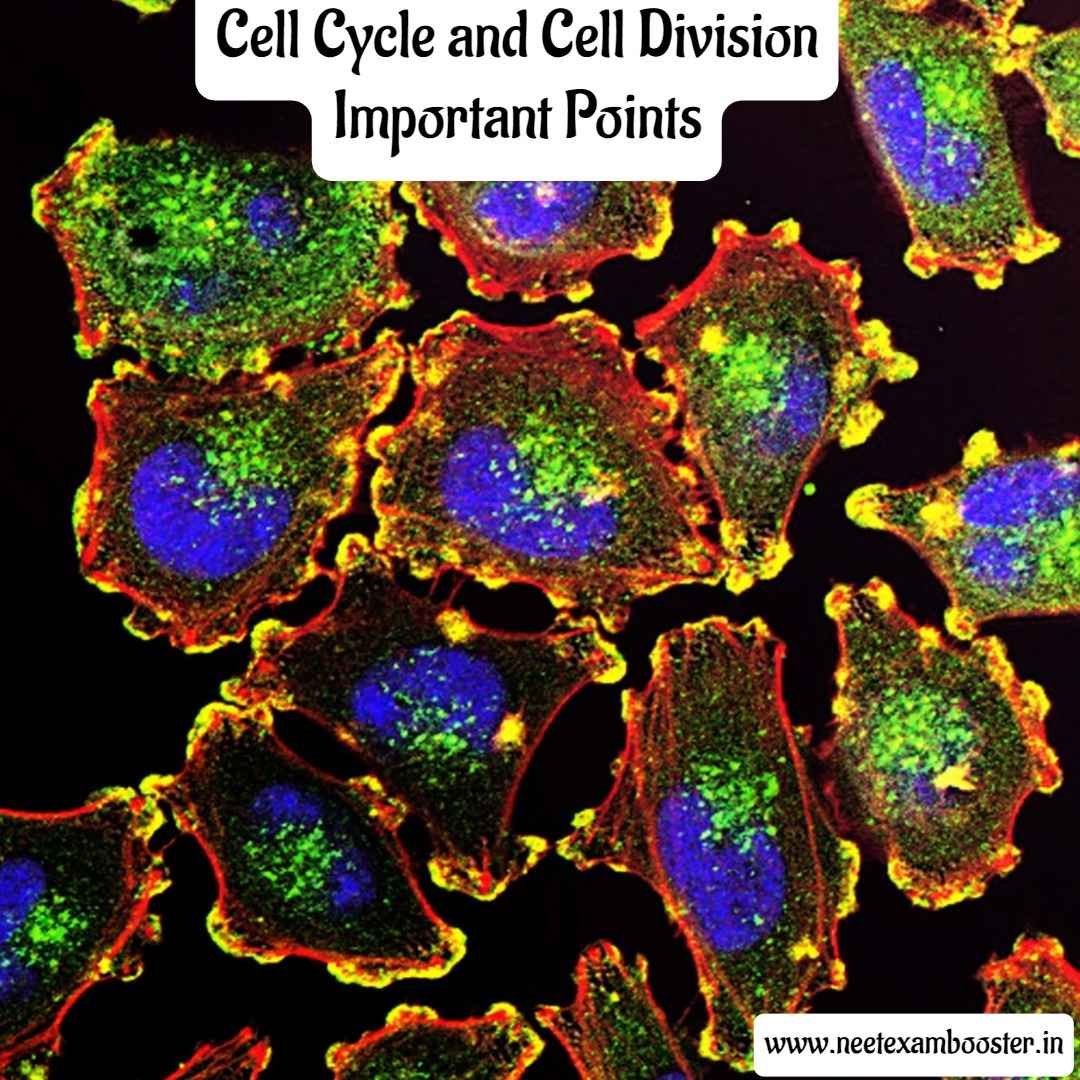Cell cycle and cell division important points: Cell cycle refers to series of the events that a cell goes through as it grows and divides into two the daughter cells. The cell cycle is classified into two main stages: interphase (G1, S, G2) and mitotic phase (M). During the interphase, cell grows and replicates its DNA in preparation for the cell division.
The mitotic phase is actual division of the cell into the two daughter cells. This process is tightly regulated to ensure proper distribution of the genetic material and the maintenance of the chromosome number.
Cell Cycle and Cell Division Important Points, Cell Cycle and Cell Division Important Points, Cell Cycle and Cell Division Important Points, Cell Cycle and Cell Division Important Points ,Cell Cycle and Cell Division Important Points ,Cell Cycle and Cell Division Important Points
NCERT Biology Class 11 Chapter 10, 25 important points for NEET – Cell Cycle and Cell Division Important Points
There are 25 important points on Cell cycle and cell division

1. Cell cycle is series of the events that takes place in a cell leading to its division and its duplication (replication).
2. Cell cycle can be divided into two main stages: the interphase (G1, S, G2) and the M phase (mitosis).
3. Interphase is a stage in which cell grows and replicates its DNA.
4. G1 phase is a stage in which cell grows and carries out the metabolic activities.
5. S phase is a stage in which the DNA replication takes place.
6. G2 phase is a stage in which cell checks for the DNA damage and prepares for the cell division.
7. Mitosis is a stage in which cell divides into two the daughter cells.
8. Chromosomes plays a crucial role in the cell division, as they contains genetic information necessary for the process of replication.
9. Chromosomes can be visualized during the cell division using a technique known as chromosome staining.
10. Mitosis can be further divided into different stages i.e. the prophase, prometaphase, metaphase, anaphase, telophase, and the cytokinesis.
11. Prophase is a stage in which chromatin condenses into the visible chromosomes.
12. Prometaphase is a stage in which spindle apparatus forms and chromosomes gets attached to the spindle fibers.
13. Metaphase is a stage in which the chromosomes align at center of the cell.
14. Anaphase is a stage in which chromosomes separates and are pulled towards the opposite poles of the cell.
15. Telophase is a stage in which chromosomes reaches the opposite poles and forms a new nuclei.
16. Cytokinesis is a stage in which the cytoplasm divides, forming the two separate daughter cells.
17. Mitosis ensures accurate distribution of the chromosomes to each daughter cell, maintaining proper chromosome number.
18. Meiosis is a type of cell division that reduces chromosome number by half, producing the genetically diverse cells.
19. Meiosis also includes the two rounds of cell division, meiosis I and meiosis II.
20. Meiosis I involves the homologous chromosome separation and reduction of the chromosome number.
21. Meiosis II is similar to mitosis and results in formation of four genetically diverse daughter cells.
22. The process of meiosis is very important for the sexual reproduction, as it produces the gametes with half the number of chromosomes.
23. Abnormalities in the cell division can lead to various diseases, such as cancer.
24. Cancer is characterized by the uncontrolled cell division and the ability of the cells to evade the normal cellular control mechanisms.
25. Understanding cell cycle and cell division is crucial for understanding the fundamental biological processes and for developing the treatments for diseases such as cancer
Some Important Questions From Biology Class 11
| Chapter Name | Quiz Link |
| The Living World | Play Now |
| Biological Classification | Play Now |
| Plant Kingdom | Play Now |
| Animal Kingdom | Play Now |
| Morphology of flowering plants | Play Now |
| Anatomy of flowering plants | Play Now |
| Cell: the unit of life | Play Now |
| Biomolecules | Play Now |
| Cell Cycle and cell division | Play Now |
| Transport in Plants | Play Now |
| Structural organisation in Animals | Play Now |
| Mineral nutrition | Play Now |
| Photosynthesis in higher plants | Play Now |
| Respiration in plants | Play Now |
| Plant Growth and development | Play Now |
| Digestion and Absorption | Play Now |
| Breathing and Exchange of Gases | Play Now |
| Body fluids and circulation | Play Now |
| Excretory products and their elimination | Play Now |
| Locomotion and Movement | Play Now |
| Neural Control and Coordination | Play Now |
| Chemical Coordination and Integration | Play Now |
Some Important Questions From Biology Class 12
| Chapter Name | Quiz Link |
| Reproduction in organism | Play Now |
| Sexual reproduction in flowering plant | Play Now |
| Human reproduction | Play Now |
| Reproductive health | Play Now |
| Principles of inheritance and variation | Play Now |
| Molecular basis of inheritance | Play Now |
| Evolution | Play Now |
| Human health and disease | Play Now |
| Strategies for enhancement in food product | Play Now |
| Microbes in human welfare | Play Now |
| Biotechnology principles and processes | Play Now |
| Biotechnology and its application | Play Now |
| Organism and population | Play Now |
| Ecosystem | Play Now |
| Biodiversity and its conservation | Play Now |
| Environment issue | Play Now |



















